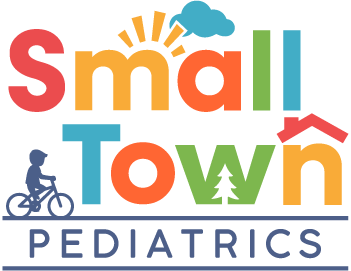
December 4, 2022
Small Town Pediatrics Update – Omicron Edition.
Everyone’s getting Covid…
We have been getting a lot of calls about exposures, tests, and symptoms. Unfortunately with the Omicron variant, our tests don’t seem to be as reliable as with earlier strains. We see families where all members have exactly the same symptoms in the same time frame, but where only half the individuals have a positive Covid test. In those cases, we believe the “negative” test results are false.
Our advice, regardless of negative or no testing, if anyone in your house has symptoms of Covid, assume you ALL have Covid. This is particularly true if:
- There has been an exposure to someone with a positive Covid test and you or your child are experiencing symptoms.
- Someone in your house is experiencing symptoms – with or without a test.
What are the symptoms?
With Omicron we are commonly seeing fever, sore throat, head and body aches, cough (often barky), and nasal congestion with or without upset stomach/vomiting.
What can you do?
- For now, expect that any of the symptoms above are evidence that you are living with Covid in your house.
- Quarantine should start for the entire household when the first person shows signs or learns of a significant exposure.
- If possible, family members with symptoms or positive tests should wear an N95 or KN95 mask (even in the house) and isolate from other family members.
- Isolate means stay in your room. Quarantine means stay in your house.
- After quarantine, everyone should wear an N95 or KN95 for at least 5 more days.
- After 5 days of quarantine, fully vaccinated and boosted people can go back to work or school without testing. People who are not vaccinated should consider a test (but remember the false negative test) or continue to quarantine for 10 days.
- The five day quarantine countdown begins the day AFTER the known exposure or symptoms appear. The countdown resets if another family member begins to show symptoms.
This is our understanding of advice from the CDC. You may hear different advice from your employer or school.
Are there any treatments?
Not really. Coronavirus is just that – a virus. There are very limited treatments – and these are not generally used in children. Those treatments are only for the most “at risk” patients, and generally only for adults. However, there are things you can do to help your child feel better.
- Cough- Give a medication syringeful of honey to any child older than 12 months. Cough suppressants should not be used in kids (they can increase risk of pneumonia). Honey has been tested against dextromethorphan (a cough suppressant) and honey works better! You can also repeat it as often as you (or your child) wants.
- If the cough is unproductive and or wheezy, kids who use albuterol might need a nebulizer treatment or 3-4 puffs of their inhaler. This may help open airways in the lung and relieve some of the cough.
- Sore throat – Gargle with warm salt water (½ teaspoon of salt in 1 cup of water). Or gargle with a 50:50 mixture of half diphenhydramine and a liquid antacid (like Maalox).
- Congestion – Apply vapor rub, and if possible flush nose with salt water. Consider an air purifier. Decongestants in younger kids tend to cause more harm than help, but older kids may benefit from a 12 hour nasal decongestant spray or from pseudoephedrine.
- Fever and muscle aches – Use a weight-based dose of ibuprofen, and soak in a tub of hot water (as hot or hotter than the fever). The hot water soak feels especially good when your child is trying to make a fever.
- Croup – Noisy breathing (particularly if breathing fast), hoarse or lost voice, pain with talking and barky cough seem to go with this variant. Standard home care for croup applies – sit or stand the child upright, let them breath cool/cold and/or humid air. If they are not having noisy breathing or increase “work”/difficulty breathing when they are calm and at rest, there is not much else needed.
- Difficulty breathing – Thankfully we are not seeing a lot of this with the Omicron variant. However, if there is distress with breathing at rest or with ordinary activity, this is always a reason to seek immediate care. Call Dr Mark or Dr Scott at any hour if you are unsure about whether your child needs immediate help. Generally, true respiratory distress should have you calling an ambulance. If you think you can take them by car, call us first.
If school or work requires a test
You may be told that a “negative” test result is needed to return to work or school. However, a negative test does not “prove” you don’t have or could not transmit Covid. Schools and workplaces requiring testing should have their own process for you to obtain these tests. Ask them to provide or direct you to testing.
We have very limited numbers of tests available. But, we are getting pretty good at recognizing the symptoms of this variant, and if it looks like a duck…
What if it isn’t Covid?
There are, of course, still other things lurking out there. Kids can still get flu, ear infections, pneumonias, strep infections and urinary tract infections. If your child has symptoms that don’t seem to quite fit, we want you to call us. So while it is safe to assume everything COULD be Covid, it is a good idea to touch base with us for things that might be more than just the worst cold you can remember.





